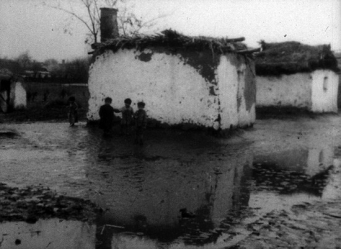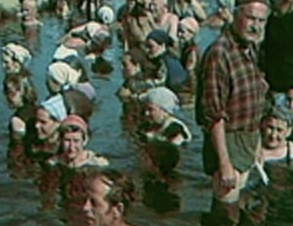Gypsies is a documentary effort by the Hungarian filmmaker Sándor Sára (b. 1933) that exposes the poor living conditions of Roma in rural settlements and the prevailing negative stereotypes about them in Hungary. Historically marginalized and exploited since arriving in eastern Europe in the 13th and 14th centuries, Roma continued to face persecution and prejudice throughout the 20th century (the term Porajmos designates their attempted annihilation during the Holocaust). Even as the Communist regime propagated an ideologically and otherwise unified socialist state, the segregation and marginalization of this minority largely continued throughout the postwar decades, although as Gypsies demonstrates, the 1960s and 1970s produced a number of state-funded works in the arts and social sciences that engaged Roma and their socioeconomic challenges.[1] Gypsies is also a prominent example of a nonfiction work that came out of the Balázs Béla Studio to take on controversial subject matter. Initially, the film was to be produced at the Budapest Film Studio, which rejected the project, deeming the original script too contentious. The film thus was moved to BBS, becoming its first documentary production and illustrating the lyrical style associated with the early period of the studio.[2]
Banner stills L to R: 10 Minutes Older, courtesy Riga Film Museum; Black Film, courtesy Želimir Žilnik; 235 000 000, courtesy Riga Film Museum
Gypsies (Cigányok)
Sándor Sára, Hungary, 1962, 35 mm transfer to digiBeta, 17 minutes

Still from Gypsies, courtesy MaNDA Archive

Still from Gypsies, courtesy MaNDA Archive
Juxtaposing newspaper headlines that decry prejudice and promote Roma integration in Hungarian society with Roma men explaining the prejudices they face when trying to get a job, as well as images of poverty and neglect pervading their community, Sára exposes the Roma’s harsh living conditions. The poetic cinematography and rhythmical editing that drive the film produce a striking visual record of the unique cultural environment of the Roma, highlighting both their archaic ways and their inevitable societal exclusion from an increasingly modernized world. Along with social critique, the film also contains a hopeful perspective, showing the education and assimilation of future generations as a key factor in the successful societal integration of this once-itinerant group. A striking example of this includes a young Roma child reciting a canonical work of Hungarian poetry, implicitly integrating the younger generation into the fabric of the nation. — Sonja Simonyi
With thanks to Sebestyén Kodolányi at the Balázs Béla Stúdió Archive and Dorottya Szörényi and the Hungarian National Digital Archive and Film Institute (Magyar Nemzeti Digitális Archívum és Filmintézet [MaNDA] for their assistance with research and for making a screening of this film possible in Washington.
One Day More (Dan više)
Vlatko Gilić, Serbia, 1971, Blu-ray from 35 mm, 10 minutes
Writing in 1974 in the New York Times, Nora Sayre opined, “Mr. Gilić’s films are called documentaries. But he’s superb at finding the astonishing images that lurk in the ordinary world. It’s as if he’d nabbed some magic from the air and wedded it to facts. And it’s a privilege to see through his eyes: Whatever interests him assumes a contagious excitement for us. It’s evident that a major talent is already well developed, and since Mr. Gilić is in his mid-30’s, we have a lot to look forward to.” One Day More (1973) belongs to a group of approximately half a dozen documentaries that the Montenegran filmmaker Vlatko Gilić (b. 1935), still considered one of former Yugoslavia’s finest filmmakers, made in the 1970s. He ended his career abruptly in 1980 due to official disapproval from the Communist authorities and consequent lack of support for his work, which had begun to move in the direction of dark and surrealistic feature films with Backbone (1977) and Day of Dreams (1980). Despite the promise that many saw in him, Gilić has not made films since then, instead dedicating himself to pedagogy as a professor in two different institutions: the Department of Directing at the Academy of Art in the Serbian city of Novi Sad and the Faculty of Fine Arts in the Montenegrin city of Cetinje. He has also been notoriously reluctant to give interviews about his earlier work, forcing film historians to rely on a handful of reviews from the 1970s for information.

Still from One Day More, courtesy LA Filmforum
Allegorical despite a lack of any plot, One Day More depicts people, many of them elderly, sitting in a large pool of mud outside the small Serbian town of Bujanovac, some deliberately smearing the substance over themselves because it is believed to cure even incurable illnesses.[3] As Sayre wrote, “Heads seem to float on the water, while mist rises in a shot that Fellini might envy.” Accompanying the film is a sung, wordless chorus that adds a liturgical and apocalyptic air to the proceedings. It highlights the condition of people who, faced with their mortality, seem willing to literally sink low in the dirt to extend life by one more day—or, as Gilić himself puts it, “Man is ready to go through hell to live one day more—and not a day less.” — Ksenya Gurshtein
With thanks to Adam Hyman, Los Angeles Filmforum, and Vera Mijojlić, South East European Film Festival, Los Angeles, who co-organized a series of screenings of Gilić’s work in the United States in 2012–13, for their assistance with research, and to Haden Guest and Mark Johnson at the Harvard Film Archive for help in making a screening of this film possible in Washington.
1. Zoltan D. Barany, The East European Gypsies: Regime Change, Marginality, and Ethnopolitics (Cambridge, 2002), 121. (back to top)
2. Lóránt Stőhr, “Elégiák” [Elegies], in BBS 50: A Balázs Béla Stúdio ötven éve [BBS 50: Fifty years of the Balázs Béla Studio] (Budapest, 2009), 80–81. (back to top)
3. According to Lorraine Mortimer, a similar kind of mud pit believed to have curative properties played a prominent role in Dušan Makavejev’s most important documentary made in his early days as a professional filmmaker. Smile ’61 (1961) showed work brigades constructing an important national road from Belgrade to Skopje, but “scarcely two hundred meters from this symbol of progress and modernity was a huge mud pool where people came to bathe, believing in the mud’s curative capacities.” Makavejev got flack from at least one prominent film critic for his “inhumanity,” since the critic believed “the young brigade members should have helped the deluded people to get out of the mud.” In the end, the film won the first prize for documentary films at the national festival of film. Lorraine Mortimer, Terror and Joy: The Films of Dušan Makavejev (Minneapolis, 2009), 9. (back to top)
